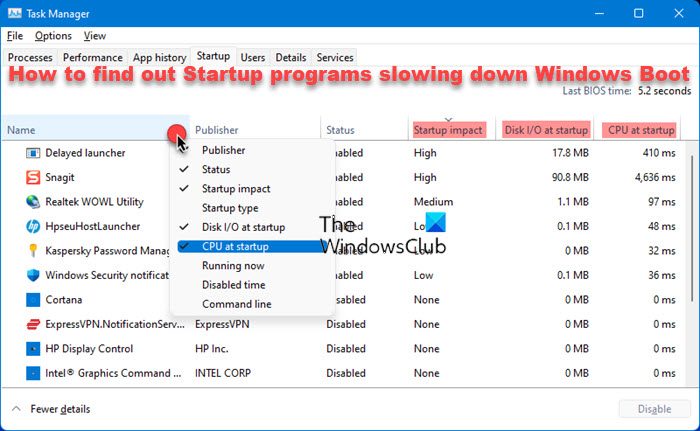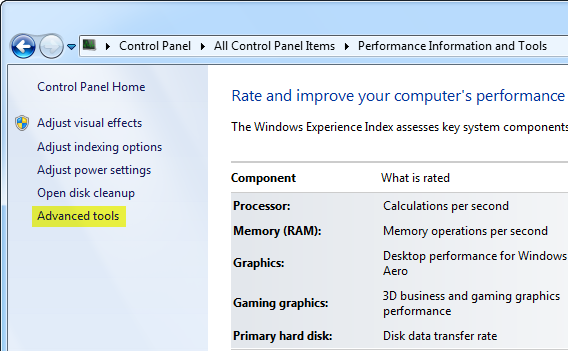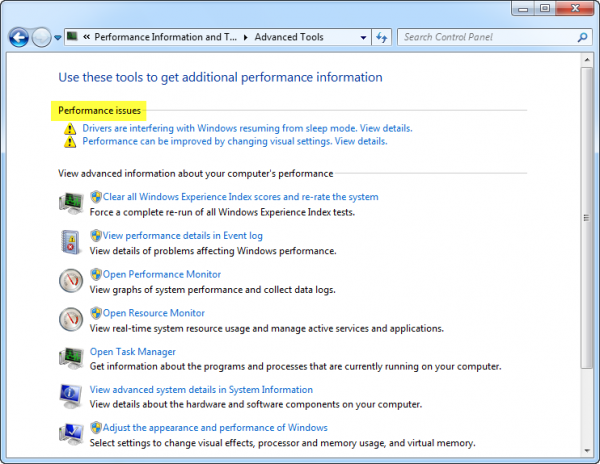If your Windows computer seems to shut down slowly or start up slowly, or if it doesn’t enter power-saving modes, it’s possible that a program or device driver is interfering with Windows power settings. In this post, we will show you how to identify or find out the apps or programs that are slowing down Windows 11/10 startup & increasing computer boot time.
How to find hidden Startup programs slowing down Windows Boot

In Windows 11 or Windows 10, to find out the apps or programs that are slowing down Windows boot, do the following:
- Open Task Manager
- Right-click on any of the column names eg. Name
- Select the following:
- Disk I/O at startup
- CPU at startup
- Now switch to the Startup tab & focus your attention on the Startup impact column. Here you will see the processes or programs that have a:
- High,
- Medium or
- No impact on startup times.
- Next, focus on the Disk I/O at startup and CPU at startup columns and identify the processes that have high figures.
In this way, you can find out the programs that are slowing down Windows 11/10 boot. You can then go on to disable Startup programs in Windows using Task Manager, WMIC, GPEDIT, Task Scheduler, MSCONFIG, Settings
Read: How to find out what startup programs I can disable safely in Windows
Detect programs, drivers slowing down a fast start-up, shutdown
In Windows 8.1 and Windows 7, you can use Performance Information and Tools to try to detect these programs or device drivers.
To check for performance issues, go to the Control Panel and open Performance Information and Tools. Now, in the left pane, click Advanced tools.
In Advanced Tools, under Performance issues, click any issues that are listed.
Read the information in the dialog box that appears to learn which programs or drivers are causing problems.
If a program or driver prevents your computer from turning on quickly. You can try the following tasks to fix the problem:
- Manage the programs that run at startup: Some programs start automatically when you start Windows. Too many of these programs opening at the same time can slow down your computer. To disable these programs from startup and improve performance, use Windows Defender or run MSCONFIG from the start menu.
- Check with the manufacturer of the program or driver for an update. A newer version of the program might include a resolution to the problem.
Read: List of Startup Paths, Folders and Registry Settings in Windows
If a program or driver prevents your computer from turning off quickly. You can try the following tasks to fix the problem:
- Close the program before shutting down: It’s possible that the problem occurs only if the program is running. Try closing the program before shutting down Windows, and then see if your computer turns off properly.
- Check with the manufacturer of the program or driver for an update. A newer version of the program might include a resolution to the problem.
If these options don’t solve the problem, then the program or driver might be incompatible with Windows. If you installed the program or device yourself and you no longer use it, consider removing the device, or uninstalling the program or driver.
How to make Windows start, run, shutdown faster may also interest you.
Related read:


I have not Performance Information and Tools in my Control Panel in Windows 8.1
I CANT FIND THIS OPTION IN MY WINDOWS 10 PRO LATEST BUILD. ANY SUGGESTIONS? THANK YOU.
Hmmm I think it was available in Windows 7 only. In Windows 10 you will something similar here: Control Panel > All Control Panel Items > Security and Maintenance. Here you see messages to resolve problems if any.
ok, thank you. i dont see it. anyway i just use some utilities to modify the start up or msconfig or task manager. but i was thinking that the performance tools could be better. anyway, thanks for lots of your tips i have learned a lot from windows club, more power to you and the windows club. :)